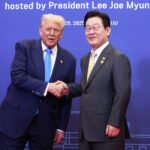(In August 2025, South Korean President Lee Jae-myung paid state visits to Japan and the United States, choosing Japan as his first destination. The South Korean government also announced that Lee Jae-myung would not attend the military parade held in Beijing on September 3. In foreign policy, the progressive Lee Jae-myung has largely inherited the conservative Yoon Suk-yeol’s diplomatic stance—namely, aligning with the United States and Japan, relying on them for security, maintaining economic relations with China while keeping a certain distance. The author already wrote an analysis two years ago on President Yoon’s U.S. visit, which signaled South Korea’s diplomatic shift. It is reproduced here.)
In April 2023, South Korean President Yoon Suk-yeol visited the United States, held talks with U.S. President Biden, delivered a speech at Congress, and reached a series of important agreements. During his Congressional address, Yoon publicly praised the U.S. military’s defense of South Korea during the Korean War, and he specifically mentioned the historical episode in which the U.S. 1st Marine Division “miraculously broke through the encirclement of 120,000 Chinese troops” at the Battle of Chosin Reservoir. Yoon’s remarks were not merely a discussion of history, but a declaration of his real-world position of clearly siding with the United States amid the strategic rivalry between the two superpowers, China and the U.S.
In the subsequent U.S.–South Korea summit, Yoon’s administration and the Biden administration reached a series of agreements, such as the regular deployment of U.S. nuclear submarines to South Korea, enhanced U.S.–ROK–Japan military and intelligence cooperation, and maintaining a unified position on the Ukraine issue. All of these reflect South Korea’s diplomatic shift toward fully aligning with the U.S.-led Western bloc. While the strengthening of the U.S.–ROK alliance is nominally aimed at countering North Korea, its implied (and increasingly explicit) target clearly also includes China and Russia.
From the 1990s until recently, South Korea had long pursued a diplomatic strategy of balancing between China and the United States, as well as maintaining relative neutrality between the Western and non-Western camps. Yoon’s actions, however, clearly overturned this diplomatic tradition, or one could say that South Korea reverted to its Cold War position—when the South Korean military regimes were staunchly pro-U.S. and pro-Japan, and hostile to North Korea and China.
Why, then, has South Korea undergone such a dramatic shift? How have South Korea’s positions toward China, the U.S., Japan, and other external actors changed over time, and what are the motivations behind these changes? What impact will South Korea’s diplomatic transformation have on South Korea itself, the U.S., Japan, Northeast Asia, and the broader world order?
After Japan’s surrender in 1945, the Korean Peninsula was divided in two, and from 1950 to 1953 it witnessed a war that caused millions of deaths. North and South Korea, though one people, became victims of the confrontation between the U.S. and Soviet blocs. During the Cold War, South Korea was a U.S. ally in Asia. Japan, also an American ally and member of the Western bloc, was likewise an important partner for South Korea. China and the Soviet Union, as allies of the “Democratic People’s Republic of Korea,” were naturally South Korea’s enemies. From the late 1980s to the early 1990s, as relations between the two blocs eased and the Cold War came to an end, South Korea gradually improved relations with China and the Soviet Union (and its successor state, Russia).
Democratization in South Korea allowed the left-leaning progressive forces—who were relatively sympathetic toward North Korea and China and resentful of Japan and the U.S.—to replace the right-wing military regime. South Korea’s foreign policy shifted from a one-sided alignment with the U.S. and Japan to a more balanced approach: maintaining the U.S.–ROK alliance and economic integration with Japan, while vigorously promoting friendly relations with China and showing enormous goodwill toward North Korea. This was most evident during the administrations of Kim Dae-jung and Roh Moo-hyun.
During the administrations of conservative politicians Lee Myung-bak and Park Geun-hye, although they adopted a hardline, hostile stance toward North Korea and strengthened ties with the U.S. and Japan, they remained friendly toward China and actively promoted South Korea–China exchanges. To a large extent, this was because China’s rapidly growing and massive economy made it an extremely important trade partner for South Korea. Furthermore, South Korea hoped China would use its influence over North Korea to restrain Pyongyang’s nuclear and missile ambitions and prevent aggression against the South.
South Korea’s pro-China stance in recent years also has deeper historical roots. The Korean Peninsula was long influenced by the profound and rich Chinese civilization: for centuries, Korea used Chinese characters to write its own language (only in recent decades were they gradually abandoned); dynastic institutions, ideology, and court rituals were all shaped by China’s central dynasties; social norms, customs, interpersonal relations, and daily life deeply emulated the culture of the Central Plains. In the Ming dynasty, the Ming court dispatched troops to help the Joseon Kingdom resist Japanese invasions (the Imjin War), asking for no reward. These experiences fostered a strong “pro-China sentiment” among many Koreans.
Conversely, because Japan repeatedly invaded the Peninsula throughout history—and carried out brutal massacres, plunder, and colonial rule—most Koreans deeply resent Japan, and cooperation with Japan is largely a reluctant choice for economic development or countering North Korea. Regarding another ally, the United States, Koreans do not harbor strong hostility, but the cultural distance is significant, and Koreans do not wish to be dominated by a single hegemonic power.
Therefore, many in both the South Korean government and society hoped to maintain closeness with China, distance themselves from Japan, reduce dependence on the U.S., and pursue a relatively balanced diplomacy. This formed the popular foundation for South Korea’s pro-China policies after democratization. Why, then, has South Korea now once again shifted its diplomacy—clearly abandoning the pro-China line and re-strengthening ties with the U.S. and Japan?
On the one hand, this is due to domestic political changes: pro-China progressive forces lost presidential elections, while pro-U.S. and pro-Japan conservative forces came to power. On the other hand, South Korea’s pro-China policy did not yield sufficient reciprocal goodwill or returns from China, and deeper structural contradictions and conflicts between the two countries emerged. As mentioned earlier, one purpose of South Korea’s friendliness toward China was to hope that China would restrain North Korea and prevent Pyongyang’s nuclear and missile programs from threatening South Korean security. Yet over the past two decades, North Korea has persisted in nuclear tests and missile launches, and even staged bloody border provocations against the South—none of which China managed to stop. The China-led “Six-Party Talks” continued for years and went through multiple rounds of negotiation, but ultimately ended without results. China’s other mediation efforts regarding inter-Korean relations and the nuclear issue also produced no substantive progress, and in some respects even emboldened North Korea’s nuclear and military ambitions. In reality, China has lost its ability—and shows no willingness—to restrain North Korea’s reckless actions.
The deployment of THAAD in South Korea near the end of the Park Geun-hye administration marked the moment when South Korea no longer expected China to solve the North Korean nuclear issue, and instead gradually began treating China as a hypothetical adversary aligned with North Korea. China’s initial strong protests followed by de facto acceptance further empowered pro-U.S. and pro-Japan forces in South Korea. Even after Park was ousted in the “Choi Soon-sil scandal” and the pro-China Moon Jae-in came to power, THAAD remained deployed in South Korea.
In addition, both progressives and conservatives in South Korea hope for eventual reunification of the Peninsula under South Korean leadership. They also hope China would support this process. However, for various reasons, China has been unwilling to promote unification. Instead, China consistently supports the Kim regime in the North and maintains the Peninsula’s division. This has frustrated all factions in South Korea.
Regarding Japan, China does not harbor the same intense, heartfelt anti-Japanese sentiment that South Korean progressives do. On the contrary, because of strategic and economic considerations, China is reluctant to confront Japan directly. For instance, when China and South Korea planned a joint film project on their cooperation against Japanese invasions in ancient and modern times, South Korea was eager, but China, concerned about its relations with Japan, refused to portray strong anti-Japanese emotions in the film, and the project was shelved indefinitely. On other issues involving Japan—such as “comfort women” and forced labor—China likewise cares more about Japan’s reactions than South Korea’s feelings. This left South Korea’s anti-Japan, pro-China supporters feeling neglected, reducing their enthusiasm for cooperation with China.
A more fundamental reason for the erosion of South Korea–China relations is the vast difference in political systems and China’s recent political trajectory. Since the late 1980s, South Korea has gradually moved toward democratization; social and political freedoms have increased, and public awareness of human rights and legal protections has significantly improved. China, both at the official and grassroots levels, presents an entirely different picture.
This divergence has created deep ideological and value-based incompatibilities between the two countries. In the eyes of many Koreans, today’s China no longer resembles the civilizational center that radiated culture during the Han, Tang, Song, and Ming dynasties; instead, it resembles the “sinicized yet alien” regimes of the Mongol Yuan or Manchu Qing dynasties.
In recent years, China’s political developments have become increasingly concerning: political reform has stagnated, society has grown more closed, and its foreign policy often appears irrational and unreasonable. These trends have caused dissatisfaction and unease in many countries, including South Korea, who no longer see China as a reliable partner.
For these reasons, even the pro-China Moon Jae-in could not reverse the deterioration of South Korea–China relations. The conservative Yoon Suk-yeol’s decision to pivot completely was entirely predictable. Yoon’s emphasis on defending “freedom and democratic values” in his U.S. Congressional speech openly articulated the fundamental reason for South Korea’s alignment with the U.S. and distancing from China.
Given that China’s political system, domestic and foreign policies, and national values show no signs of short- or medium-term change, it is clear that South Korea–China relations will remain strained for a long time to come. South Korea’s abandonment of the pro-China line and its balanced diplomacy—its re-integration into a firm U.S.–Japan–South Korea alliance, and its adoption of a confrontational posture toward North Korea and China—has become an established fact.
This outcome is deeply regrettable for the author. China and the Korean Peninsula have been closely connected since ancient times; the friendship between the two peoples is profound. Although China and South Korea were once adversaries, this was never the will of the majority in either nation, but rather the result of various internal and external forces. Both nations were liberated from Japan’s brutal colonial rule; both suffered under the hegemonic pressures of the U.S. and Soviet Union; both experienced the tragedy of national division and families torn apart. They should have cooperated to eliminate the remnants of colonialism and imperialism, not walked toward hostility. The extensive and deep exchanges between China and South Korea since the 1990s demonstrate the enormous potential for cooperation between their peoples. The renewed chill in bilateral relations today is not the fault of the people.
The author believes that the current situation is only temporary (even if it may last a long time). In the future, China and South Korea will surely restore their friendship, jointly contribute to the prosperity of Northeast Asia, and become a positive force for world peace and democracy.
(The author of this article is Wang Qingmin, a Chinese writer living in Europe and a researcher of international politics.)
submitted by /u/Slow-Property5895
[link] [comments]















